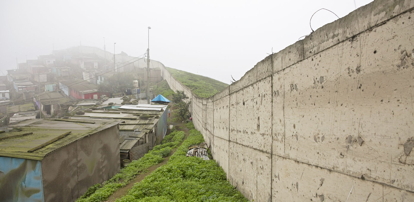
(above) The structure, a response to a wave of migration in the 1980s, now divides the Peruvian capital’s rich neighborhoods from its poor ones. Megan Janetsky
Lima’s ‘Wall of Shame’ and the Art of Building Barriers
September 7, 2019 - Original article: The Atlantic
by MEGAN JANETSKY
LIMA, Peru—They came by night, Raquel Yanac remembers, the throngs of construction workers with cement trucks and police, ready to build the wall meant to keep her out.
Yanac, 38, lives with her children on the edge of the great divide here. Their home lies amid a sea of multicolored plywood-and-metal-sheet shacks that make up the city’s slums. Just a stone’s throw away is Casuarinas, a neighborhood of startling luxury, with bright-white mansions and pools twice the size of her home.
And Casuarinas, Yanac learned that night three decades ago, wanted them gone.
“In one week, they had built up practically the entire wall, and people couldn’t do anything about it,” she told me.
The border would soon become infamous in Lima, and indigent Peruvians dubbed it “The Wall of Shame”: a six-mile-long concrete structure dividing the city’s rich and poor. Today, the nearly 10-foot-high barrier, topped with barbed wire, runs like a jagged scar through four municipalities. It divides the poor areas of San Juan de Miraflores, where Yanac lives, and Villa María del Triunfo from the rich districts of La Molina and Santiago de Surco, to which Casuarinas belongs. The concrete wall has altered the lives and perceptions of those on each side, and stands as a testament to Lima’s economic disparity, which has cut across Peruvian culture for ages.
“What do I tell my children?” Yanac asked. “My 6-year-old son goes up there to play, looks around, and now he’s asking me, ‘Mami, why is there that wall there?’’’
But building a wall—the physical act of cutting oneself off from “the other”—may be turning into a common phenomenon in an ever more polarized world. Much like other famous walls—Northern Ireland’s “peace walls,” the barrier Israel erected along its border with the Palestinian areas, the Berlin Wall, the structure lining the U.S.-Mexico border—Lima’s became emblematic of already stark social divisions.
Read more: Belfast, aspiring to normal
“It’s part of this global trend of a ‘wall,’” Belen Desmaison, an architect at Pontifical Catholic University of Peru researching Lima’s wall, told me, “this trend of actually putting up this physical barrier between two social groups or ethnic groups.”
(below) The barricade constructed by the elite Jesuit school, La Inmaculada runs into the hills of Lima, Peru's wealthy zone of Santiago de Surco. (Megan Janetsky)
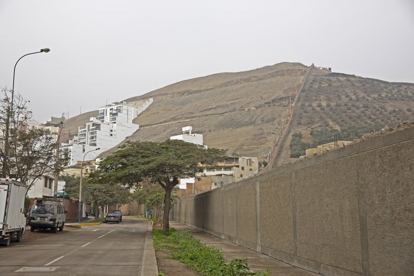
Peru’s wall was a response to a wave of migration from rural zones in the 1980s that was prompted by violence between the Peruvian government and the Shining Path, the Maoist guerrilla group. Some who fled saw Lima as simply a place to escape the bloodshed; others saw it as a place of opportunity. But without land, many migrants settled in abandoned hillsides on the edge of the city, and constructed the ever-expanding mass of informal settlements that stretch into low-hanging clouds. Susana Galinas Tacuri’s parents were among those fleeing from Ayacucho, the heart of the violence in southern Peru.
The guerrillas “killed our uncles and cousins,” Galinas told me. “They would kidnap the younger 10- and 14-years-olds to do terrorism. They would steal all their money and wool with shotguns and they would rape women.”
In Lima, they built a small shanty, and while it didn’t have lights or running water, it was safe, so it was home. Growing up, areas like Casuarinas were an economic lifeline for migrants like Galinas. Every day, workers walked to the neighborhoods to clean homes, construct buildings, and in the case of Galinas’s mother, sell food. While her mother delivered lunches to construction sites, Galinas played in the lush parks absent from her own neighborhood. But as that stream of migration into Lima continued, Galinas said fear and disgust began to permeate the places where they worked.
“They look at us as if we’re thieves,” she said, “that our children are, too, and like we want to enter their houses.”
(below) Informal settlements made of shanties wind high into the hillsides of Lima. (Megan Janetsky)
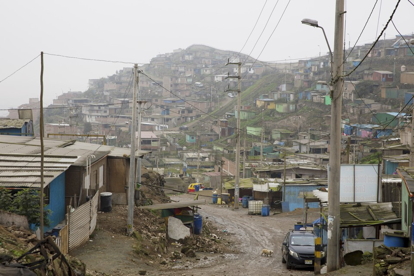
Construction on the wall began in 1985, when an elite private academy in the Surco district surrounded its grounds with tall brick fences. School officials said the barriers would serve as security from the growing migrant settlements. Soon, residents of nearby Casuarinas began building their own wall, also claiming that crime was coming from the “other side.” For three decades, the richer residents expanded that wall with the permission of local governments, in some cases bringing with them police as guards, said community leaders in San Juan de Miraflores.
Asociación Casuarinas, the neighborhood organization behind the original wall, declined an interview, saying all of its leaders were “out of town on vacation.”
However, richer residents have claimed that crime in their neighborhood has dropped as a result of the construction.
Soon, it became nearly impossible for Galinas and her mother to work on the other side. To cross, they would have to walk two hours around the wall or pay half a day’s wages to take multiple buses. Galinas’s daughter told me she dreams of playing in the same parks her mother did, but the 8-year-old has never crossed to the other side. Though workers still make the trek, some leave home as early as 5 a.m. to reach jobs that were once no more than 15 minutes from their doorstep.
About 6.9 million Peruvians live below Peru’s poverty line, which Peru defines as earning less than 338 soles ($102) per month. Income inequality has troubled the country for years. The richest 20 percent rake in nearly half its income, according to one report, while the poorest fifth earn less than 5 percent.
The wall, Desmaison, the architect, said, only widens that gap and “creates fear of the unknown” through physical separation. It’s a way, she said, to divide yourself from the group you deem inferior.
“There’s this idea of security behind the wall that creates homogeneous social groups,” she said. “If you build a wall or put a fence around the neighborhood, you’re manifesting that you’re a cohesive social group that doesn’t have any sort of dialogue with the other.”
That idea has held true worldwide. In the case of the West Bank, Israel built a wall separating itself from Palestinian communities, calling it a protection measure against terrorism. On the U.S.-Mexico border, President Donald Trump’s slow implementation of his campaign pledge to build a “big, beautiful” border wall has come amid a clamping down on immigration and stricter refugee laws. As is the case with those barriers, your view of Lima’s wall likely depends on what side you’re on.
(below) Community organizer Ricardo Cassani reads writing from a old community project discussing borders running along the 'Wall of Shame.’ (Megan Janetsky)
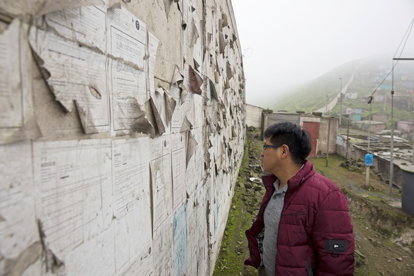
The mansions of Surco’s Casuarinas neighborhood stretch high into the mountains, and are decorated with lush gardens, pools, and collections of foreign cars parked on long driveways. Early in the morning, workers from the poor districts of San Juan de Miraflores and Villa María del Triunfo walk along carefully trimmed hedges and past decorated doorways, ignored until they arrive at the gated checkpoint they have to pass through to enter Casuarinas.
Patricia Novoa, 61, who walked briskly by that checkpoint in name-brand workout gear, has lived in Casuarinas for half her life, and was emphatic about why the neighborhood built the wall: security.
Although she hasn’t seen the other side in years, she told me, people in places like San Juan de Miraflores are “living worse than animals.” They’re criminals and thieves, she explained, because they have to be. They don’t have any other jobs.
“The people who are marginalized turn into attackers, that’s the truth,” Novoa said, as groups of workers passed by. “They don’t have a way to live, and they live in this environment where they don’t have education.”
For many others I spoke with on the streets and at the doors of their mansions, though, the question was, “What wall?” The divide that had so marked the lives of one population seemed to have faded from the consciousness of the other.
But Lily Mamani Reyes, a 33-year-old house cleaner in Surco, is reminded every morning when she wakes up at 5 a.m. to begin her nearly two-and-a-half-hour trek to work. She leaves her one-room plywood and dirt-floor home, where she struggles to get clean water, to spend her day cleaning buildings with brimming pools and carefully groomed gardens. She told me she was once paid about 50 soles ($15) a day, but because of the recent surge of Venezuelan migrants arriving in Lima, the owners cut her pay to 25 soles ($7.50), an amount she can barely survive on.
“I don’t have those comforts that they do,” she said. “Those things they have, I don’t. The clothes they have, I don’t. I can’t wear the kinds of clothes, the kinds of shoes they do … I can’t afford those kinds of luxuries.”
(below) Lily Mamani Reyes poses for a portrait outside her home in Villa María de Triunfo
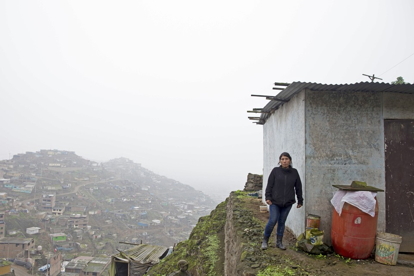
Reyes came to Lima as a 15-year-old with hopes of education and a better life than the one she left behind in her small farm town. But as she overlooked the boundless expanse of fog-cloaked slums she calls her home, she said the discrimination she feels living with the wall has shattered those ambitions, leaving behind what she could only describe as vergüenza. Shame.
“This isn’t the place you think it’s going to be when you’re a kid,” she said. “It’s not this place where you can get ahead. This wall, it’s a shame for us.”